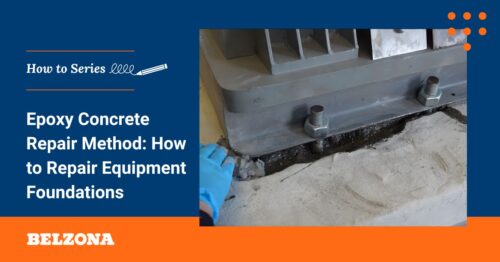This blog post is part two of a two-step guide for the protection of high-temperature process vessels. First, part one details how to mend pitting damage using the heat-resistant epoxy paste, Belzona 1511 (Super HT-Metal). This second section offers a step-by-step guide of how to apply an overcoat of the high-temperature coating, Belzona 1593, to ensure lasting protection against corrosion and chemicals.
Click Here to Read Part 1 of the Article
Once pitting damage has been repaired, Belzona recommends protecting the vessel using a high-temperature epoxy coating, such as Belzona 1593. This product was designed to provide long-term protection for process vessels operating in harsh conditions, including elevated temperatures up to 320°F (160°C) under continuous immersion in aqueous/hydrocarbon conditions.
Step-by-Step Guide: How to Repair and Protect High-Temperature Process Vessels | Part Two
Step 1: Surface Preparation Prior to Application of Belzona 1593
The Belzona 1511 (Super HT-Metal) repair has a 24-hour overcoat window, during this time the Belzona 1593 can be applied with no additional surface preparation. If applying the coating outside of this window, the surface will need frost blasting to achieve a surface profile of 1.6 mils (40 microns) prior to the epoxy coating being applied.
Step 2: Mixing the High-Temperature Coating
Next, transfer the entire contents of the Belzona 1593 Solidifier container into the Base container (or measure out a ratio of 11:1). The two components should then be mixed thoroughly to achieve a uniform colour, free of any streaks.

Step 3: First Coat of Belzona 1593
Using a brush or Belzona applicator, apply the anti-corrosion coating directly onto the prepared surface, ensuring a consistent coating. More detailed areas, such as brackets and welds, may need to be stripe-coated before the main application area. Once a uniform thickness is achieved, take regular wet film thickness readings and adjust accordingly. Make sure to evenly coat the entire prepared surface, as well as any nearby surfaces that need protection.

Step 4: Applying the Second Coat
As soon as the initial coat is sufficiently firm, a second coat should be applied for greater corrosion and chemical protection. Whilst this is usually six to eight hours after the application of the first coat, the timeframes vary depending on application temperature, so please refer to the IFU for more specific overcoat information.

Step 5: Leave Anti-Corrosion Coating to Cure
Once the second coat has cured, a DFT test should be performed to ensure the final target thickness has been achieved. Any areas that do not meet this target can be marked up and a local repair coat can be applied.
The fast-curing time of Belzona 1593 will allow a quick return to service, and once cured, this product forms a robust, chemical-resistant lining. Additionally, the system withstands the steam-out process up to 482°F (250°C) and rapid depressurisation.

Using Belzona 1511 (Super HT-Metal) for pit filling followed by Belzona 1593 for internal lining effectively repairs and protects process vessels from hydrocarbons, process chemicals, and aqueous solutions for the long term. With Belzona solutions, process vessels and other equipment can extend their service life, reducing downtime and maximising productivity.
Video: How to Repair and Protect High-Temperature Process Vessels
Frequently Asked Questions
Where can I purchase Belzona 1593?
Contact your local authorised Belzona Distributor to purchase Belzona 1593. To do this, visit the Distributor Finder page on Belzona’s website and use the contact details provided.
Where can I find the Belzona 1593 data sheet?
The Belzona 1593 data sheet is available on the official Belzona 1593 webpage, or by contacting your local Belzona Distributor. It provides detailed technical information, including application guidelines and performance characteristics.
What is the mixing ratio of Belzona 1593?
The mixing ratio of Belzona 1593 is as follows for small quantities:
11 parts Base to 1 part Solidifier by weight.
5.6 parts Base to 1 part Solidifier by volume.
Further Reading
How to Repair and Protect High-Temperature Process Vessels | PART 1
Tank Repair: How to Fix Metal Loss in Vessels (with Video)
How to Repair Pitting Corrosion
Contact Your Local Distributor to Learn More About Belzona Solutions for Process Vessels

Phil Robinson is an Association for Materials Protection and Performance (AMPP) Coating Inspector Program (CIP) Level 3 Inspector, with nearly 20 years of experience in executing major Belzona applications worldwide, both onshore and offshore. He currently holds the position of Applications and Training Director, based at Belzona’s Headquarters in Harrogate, UK. His expertise spans multiple industries, with a primary focus on the preservation of process equipment in the oil and gas sector.
In addition to his field experience, Phil plays a key role in the development of Belzona training programs, supporting Belzona’s global Distributor Network. He has also developed numerous application procedures and techniques to enhance the effectiveness of the product range. For example, in 2024, Phil was one of the key developers behind Belzona SF6-FIX, a sulphur hexafluoride (SF₆) leak solution that can be applied online, and without specialist tools.
With a passion for troubleshooting and implementing technical solutions, Phil excels at identifying and resolving complex challenges utilising protective coatings and repair composites.



